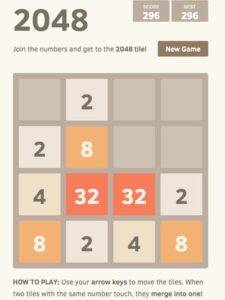2048 is a sliding tile puzzle revolving heavily around the theme of math, created by Gabriele Cirulli in 2014. Originally published on Github, 2048 is now accessible through both IOS and Android platforms, appealing to a large audience of young adults to adults, who are looking to mindlessly pass the time. Though the game revolves around numbered blocks that add up matched with another with the same number, and therefore has a prevalent math theme, it doesn’t explicitly require much math knowledge or any skills. However, 2048 is deeply strategic when it comes to the patterns and potential moves a player can do, and highly strategic due to an equal part of chance that determine how far the player gets in the game, along with strategy. 2048 ingenuinely uses the theme of math to keep the logic of the game, much like its design, simplistic and relaxing, especially through the formal elements of resources, rules, objectives, and players.
Though having a challenge aesthetic, 2048 feels more like an exploration aesthetic game, mainly due to the freedom its simplistic design and use of resources provide. The game is merely made up of a title, a 4×4 square with a few initial blocks, a one-line description saying to “join tiles to reach 2048, ” and a very small menu bar. There are no directions since the simplistic design doesn’t leave much space for questions- the only thing the player can the is to scroll left, right, up, or down. As the player scroll and observes the addition of the blocks, highlighted by the color choices, the objective of getting to the biggest number possible becomes inherently obvious. By using the page design, colors and space resources smartly, 2048 communicates with the players through intuition, and not reiteration, empowering the player to explore the game by themselves. The freedom and engagement such exploration creates is especially significant and addictive, and the theme of math plays the key role in this interaction, as the intuitive logic is basically the logic of addition, something known by almost everyone. Moreover, due to this freer and inherently communicative nature of the game, it doesn’t possess many rules, and especially no rules explicitly stated to the player. If something (an objective, a move, etc.) is not within the bounds, the player is encouraged to realize it by trying and failing.
” and a very small menu bar. There are no directions since the simplistic design doesn’t leave much space for questions- the only thing the player can the is to scroll left, right, up, or down. As the player scroll and observes the addition of the blocks, highlighted by the color choices, the objective of getting to the biggest number possible becomes inherently obvious. By using the page design, colors and space resources smartly, 2048 communicates with the players through intuition, and not reiteration, empowering the player to explore the game by themselves. The freedom and engagement such exploration creates is especially significant and addictive, and the theme of math plays the key role in this interaction, as the intuitive logic is basically the logic of addition, something known by almost everyone. Moreover, due to this freer and inherently communicative nature of the game, it doesn’t possess many rules, and especially no rules explicitly stated to the player. If something (an objective, a move, etc.) is not within the bounds, the player is encouraged to realize it by trying and failing.
Therefore, 2048 is a great example that uses formal elements of resources, rules, objectives, and players to provide simplistic and relaxing, glued by the overarching theme of math that dictates the main underlying logic of the game.



